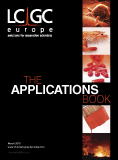Analysis of PCBs in Food and Biological Samples Using GC Triple Quadrupole GC–MS–MS
The Application Notebook
Polychlorinated biphenyls (PCBs) are a class of extremely persistent industrial chemicals manufactured for use in electrical transformers, capacitors, inks, paints, pesticides, dust control or insulating fluids. Estimates have put the total global production of PCBs on the order of 1.5 million tons.
This application details a fast, reliable and highly selective trace level screening method for the quantification of PCBs in environmental, food and biological samples, using triple stage quadrupole mass spectrometry with the Thermo Scientific TSQ Quantum GC.
Introduction
Polychlorinated biphenyls (PCBs) are a class of extremely persistent industrial chemicals manufactured for use in electrical transformers, capacitors, inks, paints, pesticides, dust control or insulating fluids. Estimates have put the total global production of PCBs on the order of 1.5 million tons.
Experimental Conditions
Analyses were performed using the TSQ Quantum GC GC–MS–MS system, equipped with a Thermo Scientific TRACE GC Ultra gas chromatograph. The TRACE GC Ultra was configured with split/splitless injector and sample introduction was performed using the Thermo Scientific TriPlus AS liquid autosampler. The capillary column was a Thermo Scientific TRACE TR-Dioxin 5MS column (5% phenyl film) of 30 m length, 0.25 mm inner diameter and 0.10 µm film thickness.
All PCB congeners at each chlorination degree were detected using two independent SRM transitions. Each transition used a different precursor ion from the chlorine isotope cluster of the molecular ion region.
Results
To test the chromatographic and mass acquisition methods with matrix samples, a number of challenging sample types were prepared. The TSQ Quantum GC demonstrated excellent sensitivity, selectivity and robustness. These results allow for comparison of the results achieved for the pentachloro-PCBs in matrices covering blood, milk, egg yolk and green cabbage. The TSQ Quantum GC provided clean and background-free mass traces for all types of matrix studied. Even in very complex samples such as blood and green cabbage, no increase in the level of background can be observed. Compared to the standard runs, the PCB concentrations in sample range from a mid-femtogram (fg) to the low picogram (pg) level. PCB concentrations were measured at 0.2 and 1.0 pg/µL for native PCBs and at 100 pg/µL for all added 13 C-labelled internal standards. The selectivity of the TSQ Quantum GC virtually eliminates matrix interference, allowing for low detection limits, enhanced confidence in quantitative results and accurate identification of these compounds.

Figure 1
Conclusions
The Thermo Scientific TSQ Quantum GC facilitates the screening and quantification of PCBs at low levels in difficult matrix samples and provides results with high certainty. The analytical set-up complies with USEPA Method 1668A, following an isotope dilution quantification protocol. The added 13 C-labelled internal standard components were detected with high reliability as demonstrated in different samples with complex matrix background. Confirmatory methods provide information on the chemical structure of the analyte. The TSQ Quantum GC with its unique hyperbolic quadrupole technology offers super or and uniform selectivity for low level PCB samples in different complex matrices. Using the TSQ Quantum GC in H-SRM mode, the PCB pattern that is typical when using high resolution mass spectrometry, such as magnetic sector, can be detected. The proposed MS–MS measurement scheme using two precursor ions and SRM detection of individual product ions is a valuable solution for screening for PCBs in various complex matrices at the relevant levels. For the fast control of food samples, GC–MS–MS with the TSQ Quantum GC exceeds the current EU directives for a minimum of four identification points,1 in that this method offers five identification points.2 For contract and governmental control labs, the TSQ Quantum GC provides a high productivity solution with increased sample throughput even for complex matrix samples. The TSQ Quantum GC delivers ultimate performance in PCB trace analysis with the added economic advantage of reduced clean-up methods.
References
1. Method 1668, Revision A: Chlorinated Biphenyl Congeners in Water, Soil, Sediment, and Tissue by HRGC/HRMS, United States Environmental Protection Agency, Office of Water, EPA No. EPA-821-R-00-002, December 1999
2. EU Commission Directive 96/23/EC concerning the performance of analytical methods and the interpretation of results, 12 August 2002, see http://eur-lex.europa.eu

Thermo Fisher Scientific Inc.
2215 Grand Avenue Parkway, Austin, Texas 78728, USA
tel. +1 800 532 4752 fax +1 561 688 8731
Website: www.thermo.com

New Study Reviews Chromatography Methods for Flavonoid Analysis
April 21st 2025Flavonoids are widely used metabolites that carry out various functions in different industries, such as food and cosmetics. Detecting, separating, and quantifying them in fruit species can be a complicated process.
Analytical Challenges in Measuring Migration from Food Contact Materials
November 2nd 2015Food contact materials contain low molecular weight additives and processing aids which can migrate into foods leading to trace levels of contamination. Food safety is ensured through regulations, comprising compositional controls and migration limits, which present a significant analytical challenge to the food industry to ensure compliance and demonstrate due diligence. Of the various analytical approaches, LC-MS/MS has proved to be an essential tool in monitoring migration of target compounds into foods, and more sophisticated approaches such as LC-high resolution MS (Orbitrap) are being increasingly used for untargeted analysis to monitor non-intentionally added substances. This podcast will provide an overview to this area, illustrated with various applications showing current approaches being employed.

.png&w=3840&q=75)

.png&w=3840&q=75)



.png&w=3840&q=75)



.png&w=3840&q=75)










